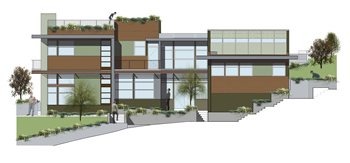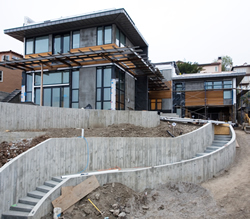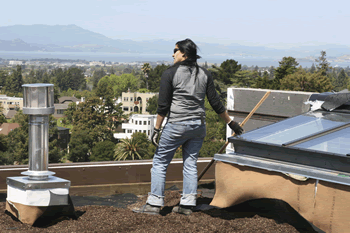Mike McDonald makes sense of sustainability…starting with his own home

In the foothills outside Oakland, California, a gorgeous and entirely LEED-certified home is going up. It’s also the first house to be not only LEED-H certified but GreenPoint Rated. The project’s construction was even filmed recently by the Planet Green Network and the Associated Press has shown interest.
But this is more than just one developer’s feather in a cap: it’s his family’s home.
Mike McDonald of McDonald Construction and Development Corp. is working with his brother Patrick of the Philadelphia-based development firm Onion Flats LLC and lead architect Howard Steinberg, also of Onion Flats. Patrick McDonald and Howard Steinberg are principals for a trio of intermeshed design-build companies that concentrate on distinct professional services from development to architectural design to construction management and installation.
“This is the first greenroof we’ve done on the West Coast,” says Mike McDonald. He sees it not just as his famil y’s home but as a prototype.
y’s home but as a prototype.
Howard Steinberg agrees.
“It makes perfect sense for us to pull resources together and do this,” he says. “And as a prototype, the reference is to continue to design and build sensible, environmentally sustainable developments.”
A number of companies have contributed materials or services to make the project happen so that it truly can become a model for future designs. One of the companies involved is Huesker Inc., a Charlotte, North Carolina-based manufacturer. It supplied the capillary fabric that allows the roof system to retain and utilize water.
WASTEWATER, WASTEWATER EVERYWHERE
Stormwater management can be a contentious issue for all involved: municipalities, contactors, regulators, etc. The intensive greenroof system in the Margarido House project may be the perfect solution, particularly in urban environments with combination sewer systems that handle both sewer and stormwaer runoff.
“[Those sewer systems] are extremely overburdened,” Steinberg says. “To be dumping all of the stormwater down the drain and then having to process it at a treatment plant makes absolutely no sense.”
In Philadelphia, a change in by-laws now means that greenroofs are accepted as an on-site stormwater management approach.
The capillary fabric—HUESKER’s TGS Green Roof nonwoven fabric—holds 10-12% of its unit weight in water and contains polyester (PET) fibers made from 100% post-consumer recycled PET bottles. Combined with drip irrigation support, the mat provides vital water retention and conservation properties for a long-term, sustainable roof garden. Whether installed on a single family home, as with the Margarido House project, or on larger developments, such as the Philadelphia row houses on which Onion Flats has done so much admirable greenroofing work, the capillary mats greatly reduce runoff.
“If a developer has a choice of having to build an underground cistern or some type of retention basin versus putting on a greenroof,” Steinberg says, “and whereas costs are comparable, greenroofs are a great choice.”
But it’s not just a matter of economics for developers, property owners and sewer departments. There are many other benefits: the life of roof waterproofing membranes are extended two to three times, since the membranes are not exposed to UV degradation; greenroofs greatly improve one’s energy envelope (thus reducing mechanical system loads and costs); and, of course, one’s green space is expanded.
THE LAYERED LOOK
“You’ve got a root barrier,” Mike McDonald says, “and on top of that a capillary mat. And then from there you’ve got a drip irrigation system, two inches of clean drainage rock, a geotextile filter fabric, the lightweight planting medium and the plants.”
The Margardio House uses a system that Roofscapes Inc., Philadelphia, licenses. JIG Inc., the construction management company tied to Onion Flats and Plumbob LLC (the group’s architectural wing), is one of the affiliated contractors and is managing the installation work in Oakland.
It’s a proven approach to water retention and management in intensive greenroof systems—those that use grasses and smaller plantings and which are often designed for more interaction between the roofs and people. But this design is not applicable to all greenroofs, including extensive systems. It’s just one of the many reasons experienced design and installation is recommended.
“With the extensive systems—we try to design them to not require irrigation,” Steinberg says. “You’re working with hardier sedums. They are not intended to be walked upon other than for weeding.”
Simply put, the drainage needs are different.
In the end, as with any greenroof, one has the beauty that rests on the surface. The landscape for the intensive Margarido system has been designed by Lauren Schneider of Wonderland Garden Services. The plantings contain barrel cactus, native California grasses and a number of other species that create something of a Mediterranean landscape.
Mike McDonald and his partners hope that this example leads to more LEED from coast to coast.

Chris Kelsey is a consulting editor for geosynthetica.net. He can be reached at chris@geosynthetica.net. Two of the photos in this piece are from Melissa Kaseman. A version of this article first appeared in Fabric Architecture magazine.
PROJECT DATA
Location: Oakland, California
Capillary Mat: TGS Greenroof from Huesker Inc.
Client: Mike McDonald
Contractor: McDonald Construction and Development
Architect: Howard Steinberg, Plumbob LLC
Project Manager: Mike Dwyer
Landscaping: Lauren Schneider, Wonderland Garden Services<
br> Greenroof Installation: JIG Inc.
Project Website: www.margaridohouse.com












